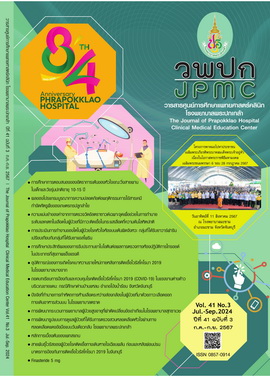Effect of the Integrated Safety Program on Pesticide Use Behaviors Among Longan Farmers
Main Article Content
Abstract
BACKGROUND: Safety behaviors are considered the most important determinants of health consequences among longan farmers.
OBJECTIVES: This quasi-experimental study examined the effectiveness of an integrated safety program on pesticide use behaviors among longan farmers.
METHODS: Thirty-five longan farmers from two districts in Chiang Mai province in Northern Thailand were purposively selected and equally assigned into an experimental or a comparison group based on inclusion criteria and matching methods (35 cases). The experimental group received the integrated safety program while the comparison group received usual care from health professionals in the community. The integrated safety program was comprised of raising awareness, modifying behavior, and creating a supportive environment for safe pesticide behavior. Data was collected by using the questionnaire at the baseline and at 8 and 12 weeks after the intervention. Data were analyzed using descriptive statistics and two-way repeated measures analysis of variance (ANOVA).
RESULTS: The results revealed that participants in the experimental group had statistically significant higher mean scores of pesticide use behaviors including pesticide use, personal protective equipment use, and compliance with safety guidance was significantly higher than before the experiment in weeks 8 and 12 (p<0.001). In addition, participants in the experimental group had statistically significant higher mean scores of pesticide use behaviors, including pesticide use, personal protective equipment use, and compliance with safety guidance, than those in the comparison group (p<0.001).
CONCLUSIONS: The results from this study indicate that an integrated safety program focused on raising awareness and creating a supportive environment for health were effective in modifying pesticide use behaviors among longan farmers. Therefore, occupational health care professionals can apply this program to promote safe pesticide use behavior among this population.
Thaiclinicaltrials.org number, TCTR20240630002
Article Details

This work is licensed under a Creative Commons Attribution-NonCommercial-NoDerivatives 4.0 International License.
References
Sharma A, Kumar V, Shahzad B, Tanveer M, Sidhu GPS, Handa N, et al. Worldwide pesticide usage and its impacts on ecosystem. SN Applied Sciences [Internet]. 2019 [cited 2023 Jan 18];1:1446. Available from: https://link.springer.com/article/10.1007/s42452-019-1485-1
Ministry of Agriculture and Cooperatives. Agricultural statistics of Thailand 2018. Bangkok: Office of Agricultural Economics; 2019.
The Secretariat of The House of Representatives. Quantity and value of agricultural hazardous substance imports 2008-2018. Bangkok: Bureau of Academic Services; 2019.
World Health Organization. Report 2021-pesticide residues in food-joint FAO/WHO meeting on pesticide residues. Rome: Food and Agriculture Organization of the United Nations; 2022.
Office of Agricultural Economics. Table showing Longan details [Internet]. 2020 [cited 2023 Feb 2]. Available from: https://www.oae.go.th/view/1/ตารางแสดงรายละเอียดลำไย/TH-TH
Khammee M, Tippila J. Safety educations of pesticide use among chillifarmers in Ban Na Yia, Rai Noisubdistrict, Mueangdistrict, Ubon Ratchathani province. Journal of Medicine and Public Health, Ubon Ratchathani University 2020;3:13-24.
Khumkong T, Kerdnoi T. Effectiveness of educational program on safety use of pesticide among farmers in Chiang Dao district, Chiang Mai province. Lanna Public Health Journal 2019;15(2):1-11.
Rogers B. Occupational and environmental health nursing: concepts and practice. 2nd ed. London: Saunders; 2003.
Levy BS, Wegman DH, Baron SL, Sokas RK. Occupational and environmental health: recognizing and preventing disease and injury. 6th ed. Oxford: Oxford University Press; 2011.
Occupational Safety and Health Administration. A guide for protecting workers from woodworking hazards [Internet]. 1999 [cited 2023 Jan 18]. Available from: https://www.osha.gov/sites/default/files/publications/osha3157.pdf
Naumanen P, Liesivuori J. Workplace health promotion activities of Finnish occupational health nurses. Public Health Nurs 2009;26:218-28.
O'Donnell MP. Health promotion in the workplace. 3rd ed. New York: Delmar Cengage Learning; 2002.
Adei D, Kunfaa EY. Occupational health and safety policy in the operations of the wood processing industry in Kumasi, Ghana. Journal of Science and Technology (Ghana) 2007;27:159-69.
Faul F, Erdfelder E, Lang AG, Buchner A. G*Power 3: a flexible statistical power analysis program for the social, behavioral, and biomedical sciences. Behav Res Methods 2007 May;39:175-91.
Wisutthananon A, Chanprasit C, Kaewthummanukul T, Suwannaprapisa T. Effect of integrated safety program on safety behaviors among rice farmers: a Quasi-experimental study. Pacific Rim International Journal of Nursing Research 2019;23:345-56.

